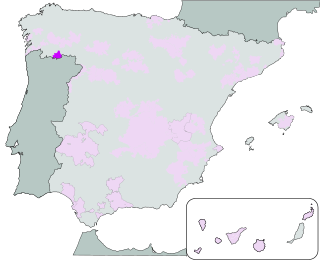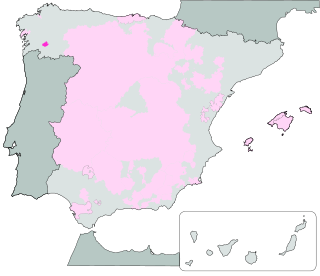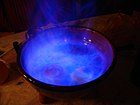In Spain, the denominación de origen is part of a regulatory geographical indication system used primarily for foodstuffs such as cheeses, condiments, honey, and meats, among others. In wines, it parallels the hierarchical systems of France (1935) and Italy (1963), although Rioja (1925) and Jerez (1933) preceded the full system. In foods, it performs a similar role, regulation of quality and geographical origin of products from Spain. There are five other designated categories solely for wine and a further three specifically covering food and condiments, all recognised by the European Union (EU). In Catalonia, two further categories – labelled A and Q – cover traditional Catalan artisan food products, but were not recognised by the EU as of 2007. In recent decades, the concept of the denominación de origen has been adopted by other countries, primarily in Latin America. In 2016, the use of the Denominación de Origen (DO) for wines was registered as a European Union Protected Designations of Origin/Denominación de Origen Protegida (PDO/DOP), but the traditional Portuguese term of DO can still be used legally on labels.

Spanish wine includes red, white, and sparkling wines produced throughout the country. Located on the Iberian Peninsula, Spain has over 1.2 million hectares planted in wine grapes, making it the most widely planted wine-producing nation, but the third largest producer of wine in the world, behind Italy and France and ahead of the United States; this is due, in part, to the very low yields and wide spacing of the old vines planted on the dry soils found in some of the Spanish wine regions. The country is second in wine exports and ninth in worldwide consumption, with Spaniards drinking, on average, 21.6 litres (5.7 US gal) per person a year. The country has an abundance of native grape varieties, with over 400 varieties planted throughout Spain, though 88 percent of the country's wine production is from only 20 grapes — including the reds Tempranillo, Bobal, Garnacha, and Monastrell; the whites Albariño, Airén, Verdejo, Palomino, and Macabeo; and the three Cava grapes Parellada, Xarel·lo, and Macabeo.

Bierzo is a Spanish Denominación de Origen Protegida (DOP) for wines located in the northwest of the province of León and covers about 3,000 km2. It borders on the provinces of Ourense, Lugo and Asturias in the north and in the south on areas of La Montaña, la Cabrera and La Meseta, in Léon. The area consists of numerous small valleys in the mountainous part and of a wide, flat plain . The DO covers 23 municipalities including the largest town of the area, Ponferrada.

Cariñena is a Spanish Denominación de Origen Protegida (DOP) for wines located in Cariñena in the province of Zaragoza. It is among the oldest protected growing areas in Europe, the DO having been created in 1932 alongside other Spanish wine regions. Cariñena vineyards are located near the centre of Aragón, about 50 km southwest of Zaragoza, on the Campo de Cariñena plateau. The lower vineyards lie at an altitude of 400 m, rising to 800 m as they approach the Sierra de la Virgen mountains. To the west they border on the Calatayud (DO).

Rueda is a Spanish Denominación de Origen Protegida (DOP) for wines located in the Community of Castile and León. It comprises 72 municipalities, of which 53 are in the province of Valladolid, 17 are in the north of the province of Segovia, and 2 are in the north of the province of Ávila. It is one of Spain's leading wine regions, and is known primarily for its white wines based on the Verdejo grape.

Utiel Requena is a Spanish Denominación de Origen Protegida (DOP) for wines located in the province of Valencia. It takes its name from the two neighbouring towns of Utiel and Requena. It is renowned for the predominant use of the Bobal grape variety.

Monterrei is a Spanish Denominación de Origen Protegida (DOP) for wines located in the southeast corner of the province of Ourense in Galicia, Spain. It covers the municipalities of Verín, Monterrei, Oimbra and Castrelo do Val.

Rías Baixas is a Spanish Denominación de Origen (DO) for wines located in the province of Pontevedra and the south of the province of Corunna in the autonomous community of Galicia, Spain. It is renowned for its white wines made from the Albariño grape variety. Its Regulatory Council is headquartered at Pazo de Mugartegui in the city of Pontevedra.

Ribeira Sacra is a Spanish Denominación de Origen Protegida (DOP) for wines located in the south of the province of Lugo and in the north of the province of Ourense, in Galicia, Spain. It extends over the territories of 20 different municipalities that make up a zone also called Ribeira Sacra, which could be translated as "Sacred Riverbank". Vineyards are planted on the steep slopes of the valleys and canyons of the rivers Miño and Sil. The area acquired official Denominación de Origen status in 1996.

Valdeorras is a Spanish Denominación de Origen Protegida (DOP) for Galician wines located on the banks of the river Sil in the south of the province of Ourense,.

Galician wine is Spanish wine made in the autonomous community of Galicia in the northwest corner of Spain. It includes wine made in the provinces of A Coruña, Ourense, Pontevedra and Lugo. Within Galicia are five Denominacións de Orixe (DO): Monterrei, Rías Baixas, Ribeira Sacra, Ribeiro and Valdeorras. In recent years, the region has seen a resurgence in its wine industry led by the international acclaim being received by the Rías Baixas region for its Albariño wines.

Barbanza e Iria is a Spanish geographical indication for Vino de la Tierra wines located in the autonomous region of Galicia. Vino de la Tierra is one step below the mainstream Denominación de Origen indication on the Spanish wine quality ladder.

Valle del Miño-Ourense is a Spanish geographical indication for Vino de la Tierra wines located in the autonomous region of Galicia. Vino de la Tierra is one step below the mainstream Denominación de Origen indication on the Spanish wine quality ladder.
Cava is a sparkling wine of denominación de origen (DO) status from Spain. It may be white (blanco) or rosé (rosado). The Macabeo, Parellada and Xarel·lo are the most popular and traditional grape varieties for producing cava. Chardonnay and Malvasia are also permitted. Authorized red grapes are Garnacha tinta, Monastrell, Trepat, and Pinot Noir. Only wines produced in the traditional method may be labelled "cava"; those produced by other processes may only be called "sparkling wines". About 95% of all cava is produced in the Penedès area in Catalonia, Spain, with the village of Sant Sadurní d'Anoia being home to many of the largest Catalan production houses. The two major producers are Codorníu and Freixenet. Cava is also produced in other villages in the provinces of Girona, Lleida, Tarragona, and Barcelona in Catalonia, Zaragoza in Aragon, Badajoz in Extremadura, La Rioja, Araba/Álava in the Basque Country, Navarra and València in the Valencian Community.

Caíño tinto is a red Galician wine grape variety that is also grown in Portugal's Vinho Verde wine region where it is known as Borraçal. In Spain, it is a permitted variety in the Denominación de Origens (DOs) of Rías Baixas and Ribeiro where it produces highly perfumed wines with noticeable tartness and high acidity.

Treixadura or Trajadura is white Portuguese wine grape variety grown primarily in the Vinho Verde wine region of northeast Portugal and the Galician wine regions of Ribeiro and Rías Baixas in Spain where the variety is known as Treixadura. The grape is primarily a blending variety that adds body and light lemony aromatics to wines. It is most commonly blended with Loureiro and Alvarinho in Rías Baixas while in Ribeiro it is often blended with Torrontés and Lado.
Camaraou noir is a red French wine grape variety that was historically grown in South West France but is now more widely planted in the Spanish wine region of Galicia where it is known as Espadeiro. However, despite its Spanish synonym Camaraou noir has no relationship to the Portuguese wine grape Espadeiro that is used to make red Vinho Verde. The grape may have some relation to the Jurançon and Béarn wine grape Camaralet de Lasseube which is also known as Camaraou blanc but DNA analysis has shown that the two varieties are distinct and not color mutations of one or the other.

Granada is a Spanish Denominación de Origen Protegida (DOP) for wines in the province of Granada, Andalusia, Spain, extending over 168 different municipalities. There is also sub-zone known as "Contraviesa-Alpujarras", covering another 13 municipalities in the Alpujarras mountains. Granada achieved Vino de Calidad status in 2009, and Denominación de Origen status in 2018.
Sierra de Salamanca is a Spanish Denominación de Origen Protegida (DOP), traditionally called a Vino de calidad con Indicación Geográfica. This is one step below the mainstream Denominación de Origen quality wines and one step above the less stringent Vino de la Tierra wines on the quality ladder. It is located in the province of Salamanca, and known for its red wines using the native Rufete grape.
Ribeiras do Morrazo is a Spanish geographical indication for Vino de la Tierra wines located in the autonomous region of Galicia. Vino de la Tierra is one step below the mainstream Denominación de Origen indication on the Spanish wine quality ladder, and mirrors the Vins de pays of French wine.




















